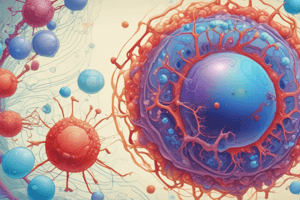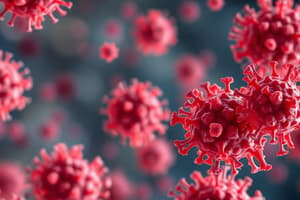Podcast
Questions and Answers
What is the primary function of the hypervariable regions in the V region of the heavy and light chains?
What is the primary function of the hypervariable regions in the V region of the heavy and light chains?
- Synthesizing immunoglobulins
- Forming disulfide bonds
- Mediating effector functions
- Participating in antigen recognition (correct)
What is the term applied to an immunoglobulin molecule with specificity for an epitope of the molecules that make up antigens?
What is the term applied to an immunoglobulin molecule with specificity for an epitope of the molecules that make up antigens?
- Antigen
- Epitope
- Immunoglobulin
- Antibody (correct)
What is the function of the C regions of the heavy chains in antibody molecules?
What is the function of the C regions of the heavy chains in antibody molecules?
- Participating in antigen recognition
- Mediating effector functions (correct)
- Synthesizing immunoglobulins
- Forming disulfide bonds
What type of cells synthesize and secrete antibody molecules?
What type of cells synthesize and secrete antibody molecules?
What is the process by which antibody molecules neutralize the binding of viruses or toxins to host cell membranes?
What is the process by which antibody molecules neutralize the binding of viruses or toxins to host cell membranes?
What determines the class of an antibody molecule?
What determines the class of an antibody molecule?
Which type of immunoglobulin variability refers to the diversity at the antigen-binding site?
Which type of immunoglobulin variability refers to the diversity at the antigen-binding site?
What is the primary function of the Fc region of an antibody?
What is the primary function of the Fc region of an antibody?
Which type of B cell is responsible for the secondary response?
Which type of B cell is responsible for the secondary response?
What is the primary difference between the primary and secondary immune responses?
What is the primary difference between the primary and secondary immune responses?
Flashcards are hidden until you start studying
Study Notes
Antigen Recognition: Immunoglobulins (Antibodies)
- Antibodies are immunoglobulin molecules with specificity for an epitope of antigen molecules, synthesized by B lymphocytes (B cells) and secreted by plasma cells.
- Antibodies provide protection by neutralizing viruses or toxins, enhancing phagocytosis and leukocyte degranulation, and activating complement activation with subsequent lysis.
Structure of Immunoglobulins
- Human immunoglobulin contains four polypeptides: two identical light chains and two identical heavy chains linked by disulfide bonds.
- Antibody molecules share the same basic structural characteristics but display remarkable variability in the regions that bind antigens.
- Heavy chains and light chains consist of amino-terminal variable (V) regions that participate in antigen recognition and carboxy-terminal constant (C) regions that mediate effector functions.
Hypervariable Regions and Antigen Binding
- Hypervariable regions of VH and VL are responsible for antigen binding by antibody molecules.
- Three short stretches in the V region of the heavy chain and three stretches in the V region of the light chain exhibit the greatest diversity, known as hypervariable regions.
Classes of Immunoglobulins
- Antibody molecules can be divided into distinct classes and subclasses based on differences in the structure of their heavy chain C regions.
- Classes of antibody molecules, also called isotypes, are named IgA, IgD, IgE, IgG, and IgM, each performing different effector functions.
Antibody Class Switching and B Cell Activation
- B cells initially express only IgD and IgM antibodies, and the class is determined by the constant region (Fc) of the heavy chain.
- B cells can switch to one of the other classes of antibody (IgA, IgE, or IgG) by replacing the tail region of the antibody in response to chemical messengers (cytokines) from T helper cells.
Bifunctional Antibodies
- Antibodies recognize and bind antigen, and promote the killing and/or removal of the immune complex through activation of effector mechanisms.
Immunoglobulin Variability
- There are three types of immunoglobulin variability: isotypic variation (present in the germline of all members of a species), allotypic variation (intraspecies allelic variability), and idiotypic variation (diversity at the antigen-binding site).
Primary vs. Secondary Immune Response
- Primary response: Lag phase (5-10 days), peak concentration (relatively low), Ig class (IgM – early response then IgG), average antibody affinity (relatively low), and responding cell (resting B cell).
- Secondary response: Lag phase (2-5 days), peak concentration (relatively high), Ig class (IgG predominates), average antibody affinity (relatively high), and responding cell (memory B cell).
Studying That Suits You
Use AI to generate personalized quizzes and flashcards to suit your learning preferences.




